#Harbour porpoise
Explore tagged Tumblr posts
Text

The lesbians are thankful
#art#anthro#digital art#artwork#edgy#furry#sheep#caprinae#bovid#harbour porpoise#cetacean#lesbian#butch lesbian#dyke#ursula lesbian#bear lesbian#lesbian bear#lesbian ursula#punk#nonbinary#original character#original art#oc art#my art#oc:wyszega#oc:kamila
359 notes
·
View notes
Note
trick or treat? :)

Happy Halloween! I hope you like your harbour porpoise!
(img src)
28 notes
·
View notes
Text
🐬Daily Cetacean Fact:🐬
Harbour Porpoise: Harbor porpoises live in northern temperate and subarctic, and arctic coastal and offshore waters. They are commonly found in bays, estuaries, harbors, and fjords less than 650 feet deep. Unlike most other porpoises, they do not approach boats to bow ride and can be very shy, avoiding surfacing near boats. When surfacing for air, they do not splash. They roll from beak to fluke and arch their backs.


#harbour porpoise#porpoise#porpoise fact#facts about porpoises#daily porpoise#daily porpoise facts#cetacean#cetacean facts#facts about cetaceans#daily cetacean#daily cetacean fact#marine animals#marine mammals#marine biology#marine life#marine life advocate#advocacy for marine life#marine#ocean animal#ocean life blog#ocean life#marine life blog#respect the locals
39 notes
·
View notes
Text
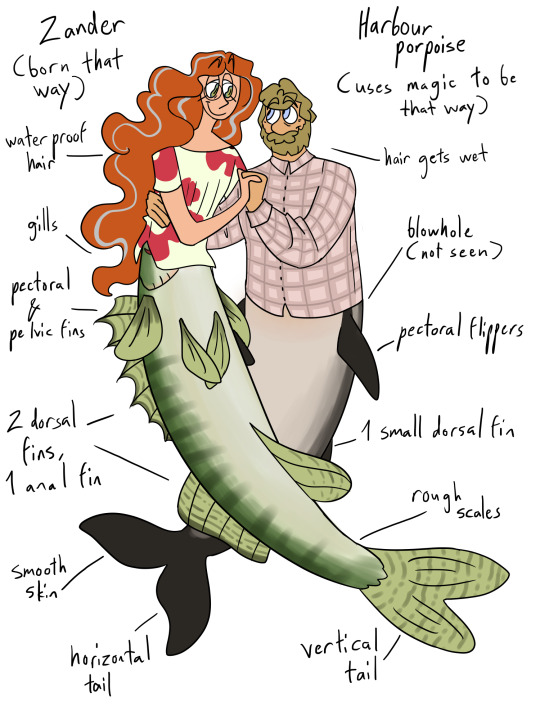
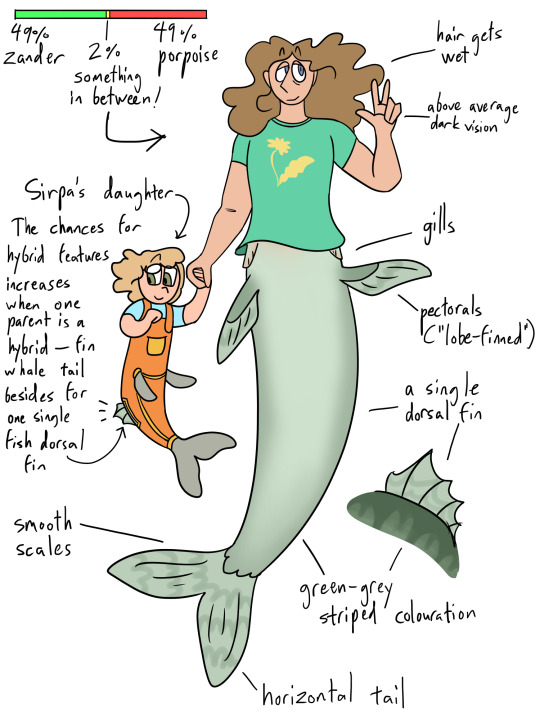
More mermaid things! I mentioned in the merfolk overview post that mermaids can use magic to become two-legged, other humans can do the same but in reverse! The spell isn't the exact same sort that created merfolk so long ago, but it does the job quite handily. Normal two-legged humans tend to gain an aquatic mammal lower body if they don't have other kinds of merfolk in their family.
In my previous art post I introduced Sirpa, who is a zander-harvour porpoise hybrid, a rare feature in half-animal people overall. Above we have Sirpa's parents, and then the mishmash of features that Sirpa inherited from them. Plus Sirpa's daughter who inherited one (1) teeny tiny fin!
#sirpa's parents' names are annika and kari lavaste (lavaste means a prop or a scenery flat.. because. the parents arent main characters)#sirpa's daughter's name meanwhile is liisa :) sirpa changed her surname so her and her daughter's surname is kartanen#dont tell me i didnt slay that zander tail!!#merfolk#mermaid#merfolk lore#zander#harbor porpoise#harbour porpoise#porpoise#art#my art#zander mermaid#porpoise mermaid#sirpaverse
49 notes
·
View notes
Text

harbour porpoise. adult male, likely fishing bycatch based on PM observations
13 notes
·
View notes
Text


2 notes
·
View notes
Text


Apparently I never shared these here? Well, better late than never! :D
I had the honor to illustrate the cover and a page for the second The Sea Unseen zine last year.
The cover features surgeonfishes, butterflyfishes, and moorish idols and it was inspired by the reef photos of @cabalrive
The page illustration features harbour porpoises and moon jellies.
I really enjoy painting marine animals, and you should check out @seaunseenzine for more incredible art from many talented artists that collaborated on this project! 💙
#fish#surgeonfish#butterflyfish#moorish idol#porpoise#dolphin#whale#harbour porpoise#jellyfish#moon jelly#cetacean#reef#sea#ocean#marine#animal#zine#the sea unseen zine#my art
39 notes
·
View notes
Text

No. 9: Porpone, the wind powered pokémon
Type: Water / Flying
Evolves from: ???
"Whenever storms rage over the oceans, Porpone can be seen soaring between wind turbines. It is said that the harder the wind rages, the more powerful Porpone become."
Name origin: the name Porpone is a combination of Harbour Porpoise and Cyclone.
Design Origin: After Furnura I decided I wanted a strong theme between my starters to tie them all together and make them more cohesive and memorable. Since Furnura is a coal furnace, I decided on basing the water starter on wind turbines. The Netherlands has a couple of offshore wind farms, so tying that in with the water starter was a natural fit.
The animal this Pokémon is based is the Harbour Porpoise (P. phocoena) which is the most common (and only?) Cetacean in the Dutch seas. Finding a semi-aquatic animal to serve as a water starter that hasn't been used yet was surprisingly hard. While I do think cetaceans don't lend themselves super well to the "out of water" experience of other water starters, I do think I can make it work with the Flying subtype.
2 notes
·
View notes
Text
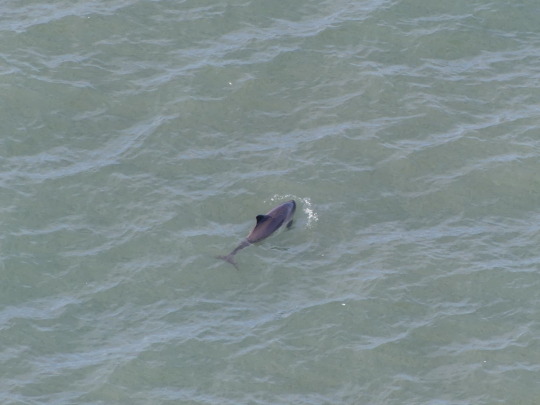
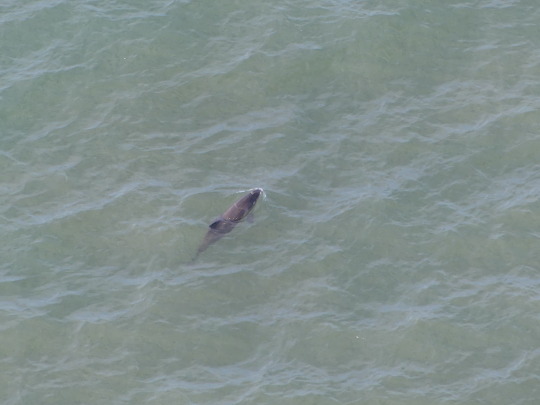
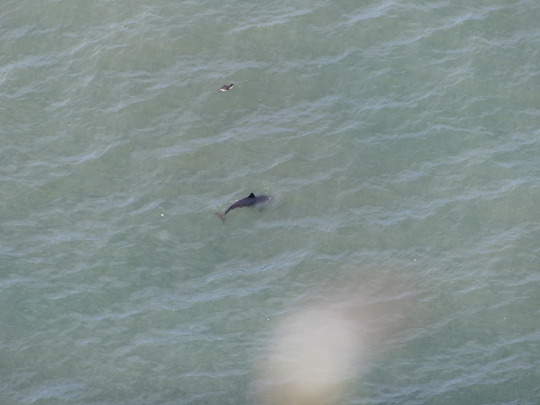
Harbour Porpoise - Bempton Cliffs
2 notes
·
View notes
Text
Russia’s War Against Ukraine Is Killing Dolphins in the Black Sea
Russia’s ongoing war against Ukraine has destroyed infrastructure and displaced about 5 million people from the country since last spring. The country’s conservationists have also noticed that the war is killing endangered Black Sea dolphins and harbor porpoises. Even Twitter Can’t Kill Twitter | Letter From the Editor Harbor porpoises and bottlenose dolphins have washed up dead on the Black…

View On WordPress
#Bottlenose dolphin#dam#Dolphin#Ecocide#Environment#Environmental justice#Environmental law#Gizmodo#Harbour porpoise#International criminal law#Jojo Mehta#Marine mammal#Pawel Goldin#Porpoise#Putin
1 note
·
View note
Photo










12th April 2023: Day four of the Scotland trip
Photos I took last Wednesday in this set are of: 1. The colourful Tobermory, a charming and memorable place to visit before leaving Mull. 2. Dazzling Black Guillemot at Fishnish just before getting the ferry back to the mainland. 3. Goosander on Loch Eil when we got back to the mainland, a key bird of the trip and very key bird of that day on Mull and the mainland. 4. One of two Ospreys we got stunning views of when back on the mainland, an amazing way to see this long time top favourite bird of mine for the first time in 2023. A revelation of the whole trip the Scottish Ospreys creating some of my best ever memories with them. 5. Otter at Dervaig back on Mull before leaving a pair seen well in the rain, we saw one before boarding the ferry at Fishnish too to really fill our boots of utterly amazing Otter sightings last week. 6. A Black Guillemot seen very well on Loch Eil, birds I love. 7, 8 and 9. Views at Loch Eil, the increased snow on the mountains following heavy precipitation after we came back from Mull was beautiful and mystical to see. 10. The stunning female Ring-necked Duck on Milton Loch which it was a huge bonus to see the first female one I’ve seen. One of my birds of the year, what a species.
Other highlights that day were Golden Plover and Greenshank on Loch Eil, Common Seal there and Red-throated Diver and Shelduck flying over there, Kittiwake a juvenile seen I believe we only saw that one that day and Common Gull seen well it was interesting to see these fairly similar birds on the same day a lot last week which we don’t usually and amazing views of Harbour Porpoise at Tobermory and on Loch Eil I always feel very thrilled to see them.
#harbour porpoise#loch eil#tobermory#dervaig#mull#scotland#uk#europe#world#earth#nature#happy#fishnish#photography#mammals#birdwatching#black guillemot#photos#osprey#ospreys#birding#greenshank#golden plover#seal#island#mainland#nature watching#wildlife watching#memories#precious
4 notes
·
View notes
Text

Porpoises by Louis A. Sargent. From Wild Beasts of the World, Vol. Two. Written by Frank Finn, published in 1909.
Internet Archive
219 notes
·
View notes
Text
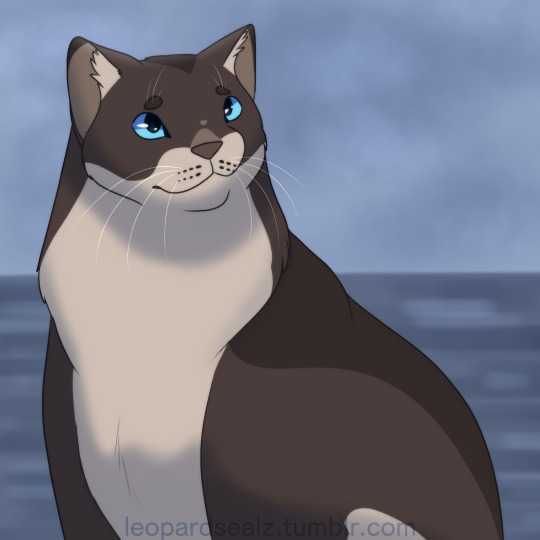
my darling porpoisestar
please reblog my art!
#wc#warriors#warrior cats#wc fanart#wc oc#warriors oc#warrior cats oc#cat oc#original character#digital art#artists on tumblr#art#sam draws#oc: porpoisestar#redesigned them just a bit#based them off a harbour porpoise of course but they also kind of look like an otter haha#first time drawing a british shorthair type face!
30 notes
·
View notes
Note
about the sea: have you sailed along the southwestern edge of the baltic sea? if yes, could you describe the land and the shore and the water there? i’m doing a little infographic on the fall migration of european starlings from Latvia to the UK (via Denmark) and i’ve never been along that coast! google maps is ok, but cannot compare to someone’s lived experience. especially with the narrative similarities between sailing and flying
this is and remains my favourite ask I have ever gotten, and it took me some time to get it right. The Baltic southwest is in my unbiased opinion the most beautiful place in the world, all year round, and I could never do it justice in all of it’s facets and different faces it wears through the year. So here are some snapshots of the southwest islands through the year, both of the sea and the shore:

Langeland, Denmark in late spring
The southern tip of the island is so flat that it nearly vanished into the sea until you are right in front of it. The belts and straits of what is lovingly called the Danish south sea are a bright blue in the first sunny days of the year. Sometimes, close to shore, yellow-green pollen bloom even creates swirling patterns in the water. There is animals everywhere; birds settled in the quieter water of the bay, mostly seagulls and loons, but swans as well; if you are very lucky, a harbour porpoise will choose the wake of your ship to swim along with, and further east, you might even meet a seal or two. The coast is green fields and white turbines turning so fast that they are blurring before you. Between it all, a constant trail of huge container ships passes the straits, turning the sky close to the water grey with their exhausts. It all seems so warm, until a single cloud passing in front of the sun reminds you of the coldness of the air.

Fehmarn, Germany in early summer
The canola fields are still in full bloom, turning the whole island a bright, joyous yellow, interspersed with specks of red and blue from the field flowers, swishing in the wind. Bright yellow and bright green against the blue backdrop of the Baltic sea. The island and the land here are flat as a pancake, making it easy to see from shore to shore; only on its edges, like a crumpled paper, does the island lift up into sandy cliffsides that drop of dramatically into pebbled beaches. Standing on the beach, the water is a azure blue, and in the sun, the numerous sandbanks are clearly visible in the light turquoise. While the wind is ever present, it is subdued in early summer, but the jagged cliffs are a stark reminder of the violence of the winter storms. All trees lean towards the shore, gnarled branches disfigured by the wind; there is a reason we call it “the land that even trees bow for”.

Ven Island, Sweden in the middle of the summer
Coming from the open water up north, the island appears like a golden hill rising out of the sea. The grainfields in full bloom, the warm sandy beaches, and the sun behind it. Behind you, the Øresund gave you the perfect reprieve, watching cities and mixed tree forest pass by in turn on either side after the rough waters of the Kattegatt, where both North and Baltic sea crash together in a cacophony of wave pattern, shaking you and your boat around frantically over strong winds. Now, on Ven, it seems almost a lifetime ago, as you follow the soft roads winding up the island and watch as grain and water are dispersed by the wind in mirrored patterns, golden and green-blue.

Christiansø, Denmark in later summer
Arriving in Christiansø is always a wild ride. While the sun beats down in unrelenting brightness, the waves and wind that had time to build over the whole Baltic sea are so strong that salt crystals form on your face from the constant sea spray that hits you in the face. The island seems almost unreal – just jagged brown-grey teeth of rock rising out of the middle of the sea with no land visible in either direction for miles, with deepest blue water surrounding it, no ground in sight. The waves crash on the stubborn rocks with a loud crashing sound, and over all of that, the stubborn calls of birds that circle around the islands undeterred. On the island, the specks of green, of still water ponds and green grass (I don’t remember a single tree), seem almost comical against the rusted brown rocks. You stare out into the dark marine blue and watch the sunset through the roaring and screeching.

Rügen, Germany in early autumn
Auttumn has arrived, and with it, heavy clouds and heavier winds. The Baltic sea, as beautiful as it is in summer, as strong are the east wind storms that start belting down on the southwest from September onwards. Without the sunlight, the water has turned a deep angry green, but mostly white, as sea foam flies over gnashing waves. Sometimes, as the water rises past your ship, you can see the last moon jellyfish of the season in long tangled webs of kelp pass you by. The rain is soft and dispersed, but colder than the water and makes visibility low. But then, the northeast of the island comes into view, as darkness has already set in, and as the wind dies down and the clouds disperse the island shines in a blinding white, the chalk cliffs of the island rising above the water. The breaking off chalk turns the water here a pastel turquoise in the sun as it dispersed, but here now, it’s dark grey, just as the sky.
#sadly i DO NOT have a picture of the chalk cliffs i do night shifts alone on the boat i can't take pictures as i am steering the boat.#sailing#baltic sea#long post#HOPE THIS HELPSSS
62 notes
·
View notes
Text


1 note
·
View note
Text
Why people think dolphins are evil - and why they're wrong
Over the past few years, social media has been demonising dolphins (I mean literally - referring to them as demons, Satan, etc) for the way they behave. So I'd like to take a look at some of the reasons people think like this and share my thoughts.
This post is pretty much only about bottlenose dolphins, as this is the species people are usually referring to. Almost all 'evil' behaviours are observed primarily in this species (out of over 40 species of dolphin.)
I've gotten these reasonings from various sources.
#1

This is what I see the most when it comes to dolphins being evil. Honestly, I find it disgusting how casually people will refer to this as rape. This is something that can affect humans for a lifetime and cause a multitude of mental health struggles. It is NOT the same for an animal. First, let me make it clear that this behaviour is uncommon. The vast majority of the time, females can decide which male to mate with and when. They may even slap unruly males with their tails to keep them at bay. Other dolphins may step in and actually protect females being bothered by some males. But should a male forcefully copulate with a female (which is not rape, a human concept) it is not with malicious intent. They don't have the morals of humans and just act on instinct. I've also heard rumours of dolphins 'raping' humans. You can find videos online where dolphins in aquariums are trained to act as if they are humping a guest, just for some funny videos (which is a disgusting and degrading 'trick'.) But sometimes it is not trained - prolonged exposure to humans can cause dolphins to develop an unhealthy relationship with them and occasionally act sexually. Its not unusual in the animal kingdom for animals to see another species sexually when looking to mate. (And no, a human has never been raped by a dolphin, there have only been encounters where the dolphin was acting sexually.)
#2

Yes, dolphins can play with their food. However, it's more than just 'needless torture'. Playing with their food can:
°Help teach calves how to hunt
°Eliminate any choking hazards as the prey is softer and in smaller pieces
°Stun their prey making them easier to kill
°Ensure it's actually dead
°Be a source of enrichment and entertainment
And dolphins aren't alone in this behaviour. These same benefits apply to many predatory animals, such as big cats. They don't simply want to hurt another animal and they actually can display altruistic traits.
#3

Dolphins are at competition for food with harbour porpoises, among other species. Killing the porpoises reduces the food competition. It's important to animals that they have their own territory with food security - in many species this leads to fatal encounters. In the region that this article refers to specifically, there's been an increase in fishing - so, a decrease in food supply. This makes it especially important to eliminate the species they are in competition with. Dolphins don't tend to waste energy on killing something needlessly. Playing with them when they kill them can also provide the benefits listed at #2.
#4

Dolphins do not have the capacity to be evil. People seem to forget that they are animals. Animals, ofcourse, behave in an animalistic way. It can seem cruel to us - but to them, it all comes down to survival and their instincts. As mentioned before they don't have morals like we do. They may have some sense of morals, but their societies are very different to human ones, so why would we expect them to share our morals? Calling dolphins 'evil' is simply false, as this is something an animal can not be. In the past, people believed sharks had the capacity to be evil. Nowadays, people are always talking about how this is false (which it is, and it's great people have changed) BUT they then treat dolphins the exact same way, somehow not seeing the hypocrisy. No animal is evil.
#5

I honestly don't even know what to say about this one. No, dolphins can't be racist. This is a horrific lie.
#6

The dolphin involved in this incident was known as Tião. Tião was a lone male bottlenose dolphin. He spent alot of time close to shore, visiting piers and travelling with boats. He would sometimes interact with guests at the beach, becoming quite popular in the area. However, people began to harass Tião. Up to 30 people at a time would surround him, grabbing any part of him they could to drag him closer to them. People would stick icecream in his blow hole, force beer into his mouth, and not leave him alone. The man killed was drunk and harassing Tião. If you were treated this way, wouldn't you snap eventually too?

I could go on and on about this, but I'll leave it at that for now. Dolphins aren't evil. I hate the way people are wishing harm, death, and abuse on them over misinformation online. Even if dolphins were somehow 'evil' animal abuse can never be excused. I hope this can change some people's minds.

19 notes
·
View notes